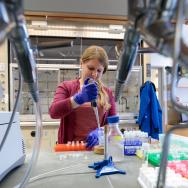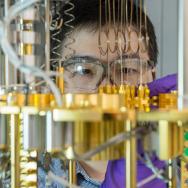Argonne National Laboratory traces its birth from a secret mission—the Manhattan Project during World War II—to create the world’s first self-sustaining nuclear chain reaction.
After that breakthrough was achieved under the University of Chicago football field stands, no one wanted to lose the momentum and scientific expertise, so on July 1, 1946, the lab was formally chartered as Argonne National Laboratory to conduct “cooperative research in nucleonics,” making it the country’s first national laboratory.
Today, 75 years later, the laboratory’s initial charge to find peacetime uses for atomic energy has grown into a broad range of innovative research that benefits humankind—from climate and sustainable energy to health and security. Argonne is now a thriving home to 3,500 employees and multiple national research facilities that draw scientists from around the world.
Operated by the University of Chicago on behalf of the U.S. Department of Energy, the lab has a rich history of scientific breakthroughs—from the most fundamental levels of particle physics and the structures of viruses to better batteries for electric cars and ways to generate electricity with nuclear reactors.
Check out a timeline of discoveries, or learn more about the lab’s history below.
Nucleogenesis
The team of physicists who would give rise to Argonne were originally part of the “Metallurgical Lab” at the University of Chicago. They constructed Chicago Pile-1, the world’s first nuclear reactor. The 20-foot-tall structure, made of graphite and uranium, produced the world’s first controlled, self-sustaining nuclear reaction on Dec. 2, 1942. The operations were then moved to suburban Palos Hills and renamed “Argonne” after the surrounding forest.
At the request of the U.S. Atomic Energy Commission—later known as the U.S. Department of Energy—Argonne began developing nuclear reactors for the nation’s peaceful nuclear energy program. In the late 1940s and early 1950s, the laboratory moved to a larger location in Lemont, Illinois, and established a remote location in Idaho, called “Argonne-West,” to conduct further nuclear research.
In quick succession, the laboratory designed and built multiple reactors, including the Experimental Breeder Reactor I, which lit a string of four light bulbs to produce the world’s first nuclear-generated electricity in 1951. Knowledge gained from the Argonne experiments formed the foundation for the designs of most of the commercial reactors currently used throughout the world for electric power generation, and continue to inform designs of liquid-metal reactors for future commercial power stations.
Meanwhile, the laboratory was also helping to design the reactor for the world’s first nuclear-powered submarine, the U.S.S. Nautilus, which steamed all the way beneath the polar ice cap.
Argonne’s campus located in Idaho (today its own lab, called Idaho National Laboratory) also produced R&D for advanced kinds of nuclear reactors. For example, in 1982, they tested the Integral Fast Reactor concept—a revolutionary design that reprocessed its own fuel, reduced its atomic waste and withstood safety tests of the same failures that triggered the Chernobyl and Three Mile Island disasters.
Fundamental breakthroughs
Alongside nuclear technology, the concentration of top scientists at Argonne meant the laboratory quickly became a pioneering hub for fundamental research in physics, chemistry and other fields.
In 1955, Argonne chemists co-discovered the elements einsteinium and fermium, elements 99 and 100 in the periodic table. In 1962, laboratory chemists produced the first compound of the inert noble gas xenon, opening up a new field of chemical bonding research. In 1963, scientists discovered the hydrated electron, which is a free electron in a solution and the smallest possible anion.
That same year, Argonne and UChicago researcher Maria Goeppert Mayer was awarded the Nobel Prize in Physics for discovering the nuclear shell model. This discovery gave scientists some of the deepest insights into the character of the nucleus and charted a new course for nuclear physics over the next several decades.
High-energy physics also made a leap forward when Argonne was chosen as the site of the 12.5 GeV Zero Gradient Synchrotron, a proton accelerator that opened in 1963. A bubble chamber allowed scientists to track the motions of subatomic particles as they zipped through the chamber; in 1970, they observed a fundamental particle called a neutrino in a hydrogen bubble chamber, the first use of this method for studying the particle.
Argonne researchers also pioneered a technique to analyze the moon’s surface using alpha radiation, which launched aboard the Surveyor 5 in 1967 and later analyzed lunar samples from the Apollo 11 mission.
The lab also cultivated a strong battery research program, including the invention in the 1990s of a revolutionary cathode material that lasted longer and stored more energy than other battery materials. The nickel-manganese-cobalt cathode later found its way into electric vehicles produced by General Motors.
A hub for discovery
Part of Argonne’s success has always been as a home for scientific facilities too large and complex for individual universities. These serve as a destination for scientists around the world; every year, more than 6,000 researchers visit these facilities to conduct groundbreaking studies in nearly every field of science and engineering.
The Advanced Photon Source, a major X-ray facility, was completed in 1995 to produce the brightest X-rays in the world. The Advanced Photon Source has paved the way for research that led to several Nobel Prizes in Chemistry, and it still runs 24 hours a day, to study everything from batteries to beetles.
In 2006, Argonne developed another national user facility, the Argonne Leadership Computing Facility. There, scientists have used several generations of supercomputers to carry out modeling and simulation experiments of materials, climate, diseases, and other phenomena and substances. These computers ranged from have included the 557-teraflop Intrepid, 10-petaflop Mira, 15.6-petaflop Theta, and the upcoming Aurora, which will be among the world’s first exascale supercomputers. Recently, artificial intelligence and machine learning have become major topics of interest as scientists seek new ways to improve the accuracy and speed of their models of systems as tiny as viruses and as big as galaxies.
The laboratory also built the Center for Nanoscale Materials, one of five Nanoscale Science Research Centers in the nation. Research at the Center for Nanoscale Materials has led to the development of everything from ultrananocrystalline diamond films for artificial retinas and accelerators to specialized sponges that can soak up enormous quantities of spilled oil.
In 2012, the Department of Energy chose Argonne to lead the Joint Center for Energy Storage Research (JCESR), which was charged with reducing the cost, increasing the energy density, increasing the lifetime, and increasing the safety of batteries—a major component of energy sustainability.
In 2020, Argonne was identified as a major player in the nation’s quantum efforts, as the laboratory was awarded Q-NEXT, a quantum information science research center that focuses on how to reliably control, store, and transmit quantum information at distances that could be as small as a computer chip or as large as the distance between Chicago and San Francisco.
University connections
Throughout its history, the laboratory has been managed through the University of Chicago, which fosters strong partnerships between University faculty and students and Argonne scientists and engineers.
This is reflected in collaborations to build cutting-edge technology to take images of the light left over from the Big Bang; in partnerships like the Pritzker School of Molecular Engineering, including running a 52-mile quantum loop; in shared ventures to accelerate technology from scientific research into the marketplace; and in daily collaborations across the two institutions in everything from synthetic tissue to rocks deep inside the Earth.
Even as the COVID-19 pandemic spread around the world, Argonne and UChicago scientists were partnering to rapidly characterize the virus and understand how to fight it; today they continue to work on novel approaches, such as one that could potentially address the coronavirus and other viruses.
Argonne’s first 75 years has seen it become a pioneer in many fields, ranging from nuclear energy to computing to X-ray science to energy storage. The nation’s first laboratory has a proud legacy of discovery upon which it continues to build today and in the future.
—Adapted from an article published by Argonne National Laboratory.

